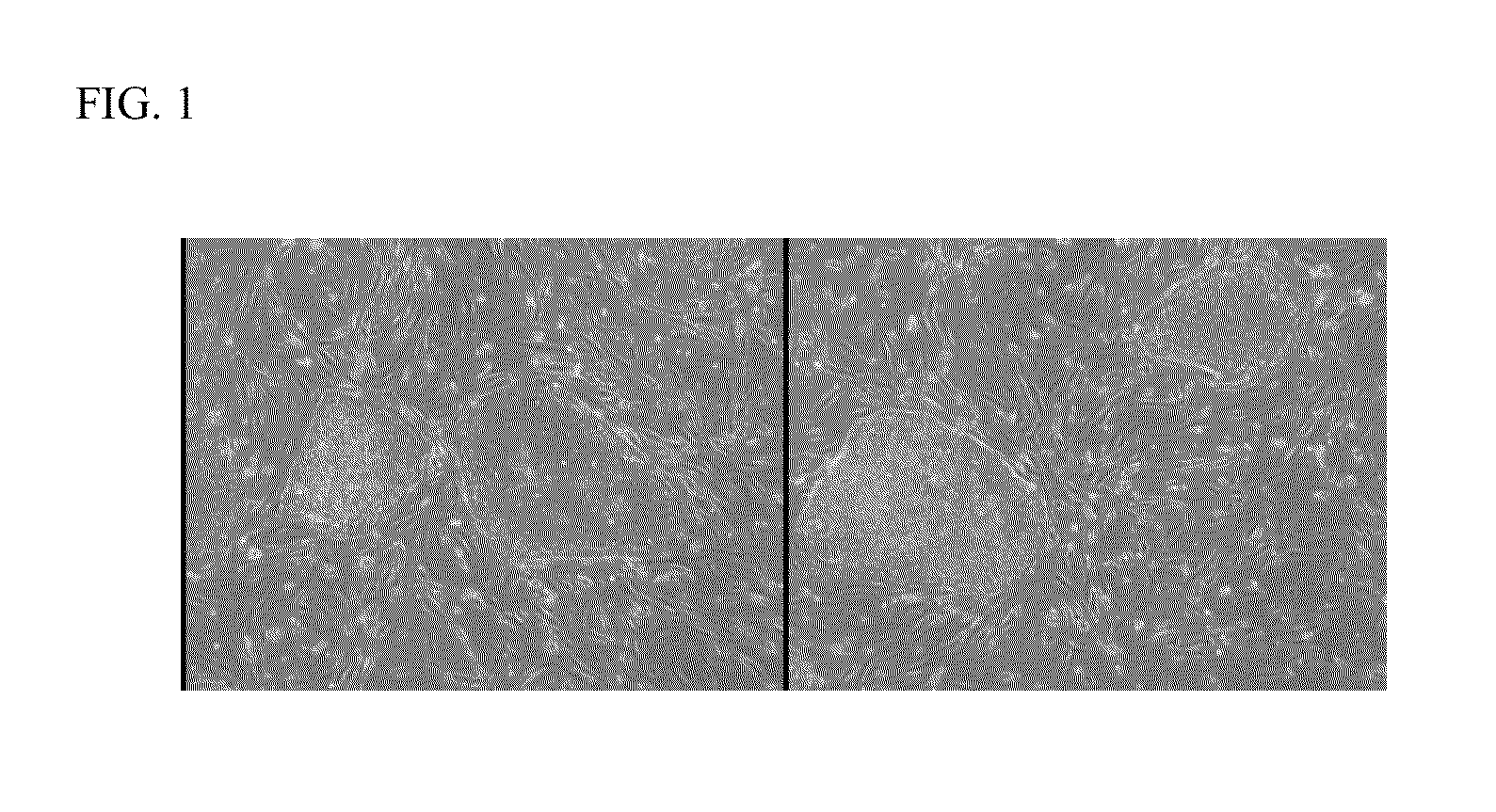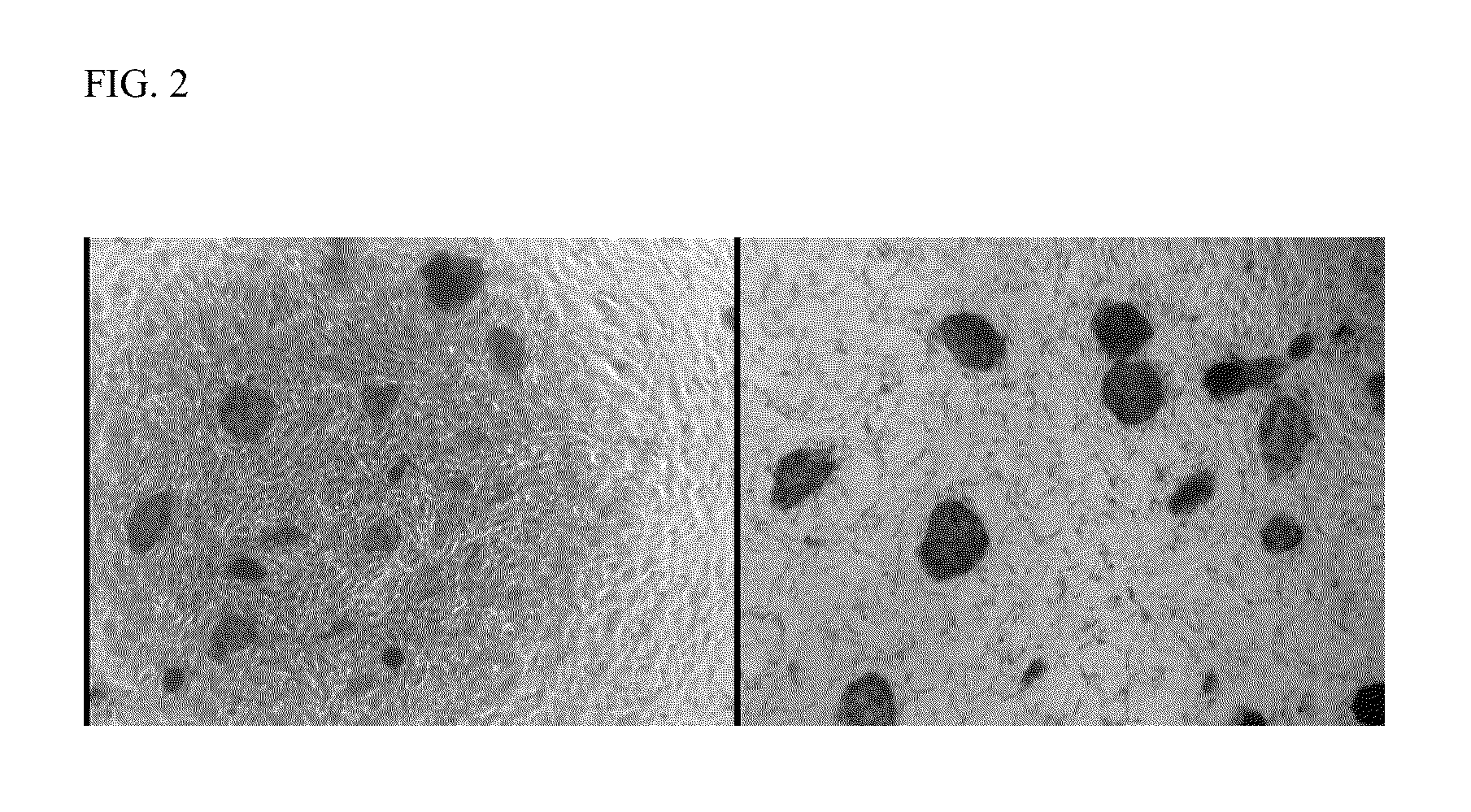Induced pluripotent stem cells from human umbilical cord tissue-derived cells
a technology of stem cells and umbilical cord tissue, applied in the field of induced pluripotent stem cells, can solve the problems of limited use of ips cells for therapeutic applications, slow process, inefficiency, etc., and achieve the effect of increasing the expression of a gen
- Summary
- Abstract
- Description
- Claims
- Application Information
AI Technical Summary
Benefits of technology
Problems solved by technology
Method used
Image
Examples
example 1
Reprogramming of hUTC into iPS Cells
[0021]hUTC obtained according to the methods described in U.S. Pat. No. 7,510,873, were transduced with murine retroviruses individually carrying constitutively expressed human transcription factors (OCT4, SOX2, KLF4, and c-MYC).
[0022]hUTC were thawed and cultured for one passage before transduction. On day 1, hUTC were trypsinized and plated onto 6-well plates at 1×105 cells per well in 2 milliliters of hFib medium (DMEM (Invitrogen Corporation, Carlsbad, Calif., catalog number 11965-092) containing 10% fetal bovine serum (FBS) sold under the tradename BENCHMARK (Gemini Bio-products, West Sacramento, Calif., catalog number 100-106, vol / vol), 2 millimolar L-glutamine sold under the tradename GLUTAMAX (Invitrogen Corporation, catalog number 35050-061), 50 Units / millilter penicillin and 50 milligrams / milliliter streptomycin (Invitrogen Corporation, catalog number 15140-122) per well. Cells were incubated for 6 hours at 5% CO2 and 37° C. Medium was a...
example 2
Expression of Pluripotency Markers
[0031]The human umbilical cord tissue-derived iPS cells prepared in Example 1 were assessed for their expression of pluripotency markers by immunocytochemistry. Following fixation of the colonies in 4% paraformaldehyde, immunofluorescent staining for pluripotency markers was performed using the antibody reagents shown in Table 1(all antibodies were obtained from Stemgent, Inc.).
TABLE 1MarkerPrimary AntibodySecondary AntibodyTRA-1-81Mouse anti-Human TRA-1-81NAAntibody, sold under thetradename DYLIGHT 549,catalog number 09-0082TRA-1-60Mouse anti-Human TRA-1-60NAAntibody, sold under thetradename STAINALIVEDYLIGHT 488, catalognumber 09-0068SSEA-3Anti-Human SSEA-3Goat anti-Rat IgG + IgMAntibody, catalog numberAntibody, sold under the09-0014tradename CY 3, catalognumber 09-0038SSEA-4Anti-Human SSEA-4Goat anti-Mouse IgG + IgMAntibody, catalog numberAntibody, sold under the09-0006tradename CY 3, catalognumber 09-0036NANOGAnti-Mouse / Human NANOGGoat anti-Rabb...
example 3
Methylation Analysis of Oct4, Nanog, and Sox2 Promoters
[0033]The human umbilical cord tissue-derived iPS cells prepared in Example 1, clone N1, were analyzed for the methylation status of the Oct4, Nanog, and Sox2 promoter regions using the bisulfite sequencing method and was performed by Seqwright, Inc. (Houston, Tex.). The bisulfite method is the most commonly used technique for identifying specific methylation patterns within a DNA sample. It consists of treating DNA with bisulfite, which converts unmethylated cytosines to uracil but does not change methylated cytosines. It is used both for loci-specific or genome-wide analyses.
[0034]Approximately 100 to 500 bp-long promoter regions of Oct4, Nanog, and Sox2 were examined for methylation patterns. DNA (see Table 2) were prepared using the DNA extraction kit sold under the tradename DNEASY (Qiagen, Inc., Valencia, Calif., catalog number 69506) and were sent to Seqwright, Inc. for analysis.
TABLE 2Sample IDSample description1parental...
PUM
 Login to View More
Login to View More Abstract
Description
Claims
Application Information
 Login to View More
Login to View More - R&D
- Intellectual Property
- Life Sciences
- Materials
- Tech Scout
- Unparalleled Data Quality
- Higher Quality Content
- 60% Fewer Hallucinations
Browse by: Latest US Patents, China's latest patents, Technical Efficacy Thesaurus, Application Domain, Technology Topic, Popular Technical Reports.
© 2025 PatSnap. All rights reserved.Legal|Privacy policy|Modern Slavery Act Transparency Statement|Sitemap|About US| Contact US: help@patsnap.com


